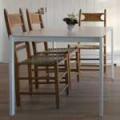My Boat, My Harbor
Every Boat Has a Story to Tell

Priscilla shows no evidence of ancient collisions, as the Hinckley Sou’wester 30 barrels past a Pilot 35 in a race off Boothbay. Photograph by Nick Mace
We were caught by a thunderstorm as the sun was going down. We entered in darkness punctuated by lightning, and went shuddering aground.
I do not take boat “collisions” lightly. At 16, I was at the helm of a Dark Harbor 17, belonging to Camp Four Winds in Sargentville, in a roaring thunderstorm. We had been sailing all day from Bucks Harbor to Blue Hill. Becalmed in Blue Hill Bay, we were caught by a thunderstorm as the sun was going down. The tide had turned and was roaring out of Blue Hill Harbor. The harbor is protected by a breakwater. Beyond the breakwater is a reef loaded with, or maybe created by, ballast rock dumped by the schooners of yore. This makes entry into the harbor tricky, even when you have daylight and the tide with you. We entered in darkness punctuated by lightning, and went shuddering aground. I remember getting the sails down, and I remember the next morning seeing the boat half sunk, but still floating in the harbor. It was high drama for a teenager, and a lesson never to be forgotten.
I do not know for certain whether Priscilla collided with a reef or another boat before my family owned her. I do know, though, that I have been and will be doubly careful about “collisions” aboard her from now on. The Four Winds Dark Harbor 17 was old when we took her onto the reef in 1962. She was repaired and continued her sail training of campers into the 1980s. The camp no longer exists and the Dark Harbor 17 may be gone, as well. Priscilla, however, is still around, and I hope she never has another “collision” while I’m at the helm.
Sally Giddings Smith grew up sailing turnabouts, canoes, and knockabouts on Maine lakes, sailed Dark Harbor 17s on Eggemoggin Reach as a teenager, and ended up teaching sailing at Mystic Seaport. She now lives in East Boothbay, Maine.















